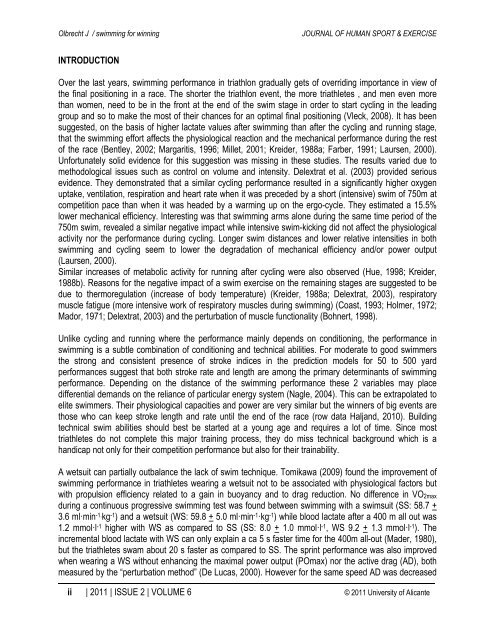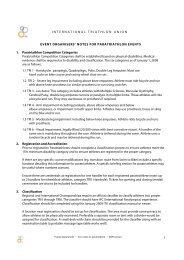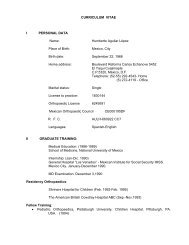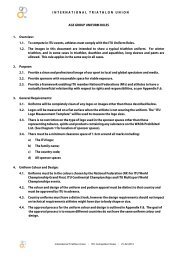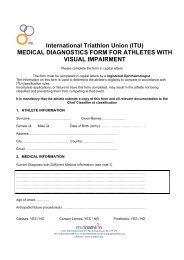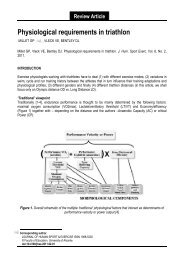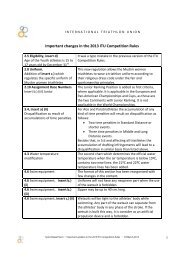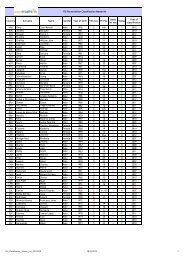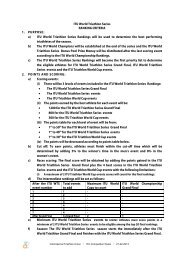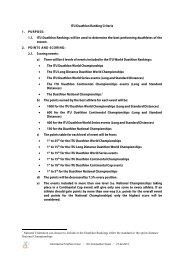Triathlon: swimming for winning
Triathlon: swimming for winning
Triathlon: swimming for winning
You also want an ePaper? Increase the reach of your titles
YUMPU automatically turns print PDFs into web optimized ePapers that Google loves.
Olbrecht J / <strong>swimming</strong> <strong>for</strong> <strong>winning</strong><br />
JOURNAL OF HUMAN SPORT & EXERCISE<br />
INTRODUCTION<br />
Over the last years, <strong>swimming</strong> per<strong>for</strong>mance in triathlon gradually gets of overriding importance in view of<br />
the final positioning in a race. The shorter the triathlon event, the more triathletes , and men even more<br />
than women, need to be in the front at the end of the swim stage in order to start cycling in the leading<br />
group and so to make the most of their chances <strong>for</strong> an optimal final positioning (Vleck, 2008). It has been<br />
suggested, on the basis of higher lactate values after <strong>swimming</strong> than after the cycling and running stage,<br />
that the <strong>swimming</strong> ef<strong>for</strong>t affects the physiological reaction and the mechanical per<strong>for</strong>mance during the rest<br />
of the race (Bentley, 2002; Margaritis, 1996; Millet, 2001; Kreider, 1988a; Farber, 1991; Laursen, 2000).<br />
Un<strong>for</strong>tunately solid evidence <strong>for</strong> this suggestion was missing in these studies. The results varied due to<br />
methodological issues such as control on volume and intensity. Delextrat et al. (2003) provided serious<br />
evidence. They demonstrated that a similar cycling per<strong>for</strong>mance resulted in a significantly higher oxygen<br />
uptake, ventilation, respiration and heart rate when it was preceded by a short (intensive) swim of 750m at<br />
competition pace than when it was headed by a warming up on the ergo-cycle. They estimated a 15.5%<br />
lower mechanical efficiency. Interesting was that <strong>swimming</strong> arms alone during the same time period of the<br />
750m swim, revealed a similar negative impact while intensive swim-kicking did not affect the physiological<br />
activity nor the per<strong>for</strong>mance during cycling. Longer swim distances and lower relative intensities in both<br />
<strong>swimming</strong> and cycling seem to lower the degradation of mechanical efficiency and/or power output<br />
(Laursen, 2000).<br />
Similar increases of metabolic activity <strong>for</strong> running after cycling were also observed (Hue, 1998; Kreider,<br />
1988b). Reasons <strong>for</strong> the negative impact of a swim exercise on the remaining stages are suggested to be<br />
due to thermoregulation (increase of body temperature) (Kreider, 1988a; Delextrat, 2003), respiratory<br />
muscle fatigue (more intensive work of respiratory muscles during <strong>swimming</strong>) (Coast, 1993; Holmer, 1972;<br />
Mador, 1971; Delextrat, 2003) and the perturbation of muscle functionality (Bohnert, 1998).<br />
Unlike cycling and running where the per<strong>for</strong>mance mainly depends on conditioning, the per<strong>for</strong>mance in<br />
<strong>swimming</strong> is a subtle combination of conditioning and technical abilities. For moderate to good swimmers<br />
the strong and consistent presence of stroke indices in the prediction models <strong>for</strong> 50 to 500 yard<br />
per<strong>for</strong>mances suggest that both stroke rate and length are among the primary determinants of <strong>swimming</strong><br />
per<strong>for</strong>mance. Depending on the distance of the <strong>swimming</strong> per<strong>for</strong>mance these 2 variables may place<br />
differential demands on the reliance of particular energy system (Nagle, 2004). This can be extrapolated to<br />
elite swimmers. Their physiological capacities and power are very similar but the winners of big events are<br />
those who can keep stroke length and rate until the end of the race (row data Haljand, 2010). Building<br />
technical swim abilities should best be started at a young age and requires a lot of time. Since most<br />
triathletes do not complete this major training process, they do miss technical background which is a<br />
handicap not only <strong>for</strong> their competition per<strong>for</strong>mance but also <strong>for</strong> their trainability.<br />
A wetsuit can partially outbalance the lack of swim technique. Tomikawa (2009) found the improvement of<br />
<strong>swimming</strong> per<strong>for</strong>mance in triathletes wearing a wetsuit not to be associated with physiological factors but<br />
with propulsion efficiency related to a gain in buoyancy and to drag reduction. No difference in VO 2max<br />
during a continuous progressive <strong>swimming</strong> test was found between <strong>swimming</strong> with a swimsuit (SS: 58.7 +<br />
3.6 ml·min -1. kg -1 ) and a wetsuit (WS: 59.8 + 5.0 ml·min -1·kg -1 ) while blood lactate after a 400 m all out was<br />
1.2 mmol·l -1 higher with WS as compared to SS (SS: 8.0 + 1.0 mmol·l -1 , WS 9.2 + 1.3 mmol·l -1 ). The<br />
incremental blood lactate with WS can only explain a ca 5 s faster time <strong>for</strong> the 400m all-out (Mader, 1980),<br />
but the triathletes swam about 20 s faster as compared to SS. The sprint per<strong>for</strong>mance was also improved<br />
when wearing a WS without enhancing the maximal power output (POmax) nor the active drag (AD), both<br />
measured by the “perturbation method” (De Lucas, 2000). However <strong>for</strong> the same speed AD was decreased<br />
ii | 2011 | ISSUE 2 | VOLUME 6 © 2011 University of Alicante


